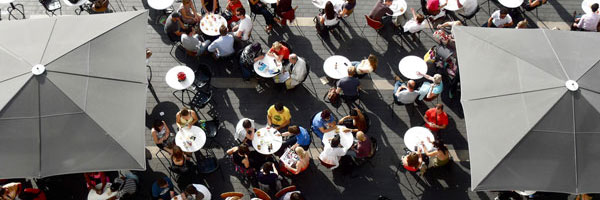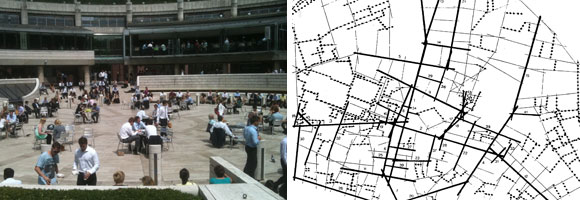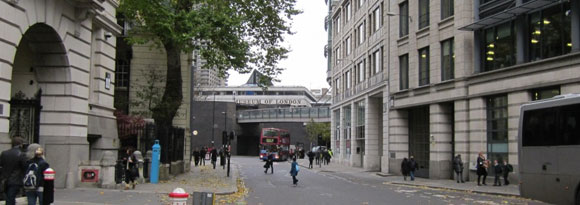
As the Internet creates greater levels of online connectivity, the demand for face-to-face human interaction, far from being replaced, is more valued than ever. The “Big Bang” of the 1980s emancipated the financial services industries, allowing international trading via telephone and modem. Yet never have the trading floors, coffee shops and public spaces of the City of London been more active.
The 25-year history of Space Syntax has coincided with the emergence of this phenomenon. One of our earliest projects was to study public life in the Broadgate development, which redefined public space use in the City and exposed the myth that the British were an indoor race.
In this month’s Newsletter, we look back at Broadgate and consider the phenomenon of “being central” to the benefit of human interaction.
![]()
Anna Rose
Director
Space Syntax helps our clients and design partners meet their human behaviour objectives. Together, we have seen too many new, empty plazas to know that the Urban Buzz doesn’t just happen by chance. Instead, we know that it needs to be crafted through careful analysis and design. We have identified principles of human behaviour that guide the advice we give: for example, 1. movement networks that are well embedded in their urban context and 2. simple, direct paths and 3. the habit of people to select locations in public spaces that give them good views into their surroundings. Designing with these principles in mind helps take away the risk of functional failure when creating new places.
We have seen the damage that over-complicated, over-enclosed public spaces have created. To avoid this, we have established an analytic approach that creates wonderful, serendipitous public spaces.

Project Broadgate
Project Director Bill Hillier
Client Rosehaugh Stanhope
Date January 1990
Broadgate is the largest office development in the City of London, built around a series of pedestrian routes and public spaces. By taking a place-based approach, Broadgate broke the mould for property development in the UK, where the market had previously created sterile, inward-facing and car-oriented office complexes.
Space Syntax was appointed following completion of the first, highly successful phase of Broadgate, designed by Arup Associates. Developer Stuart Lipton wanted to know whether, and to what degree the success of the development was down to its physical and spatial design, so that lessons learned could be applied in subsequent phases.
Space Syntax took a three-part approach to answering this question: first, observing pedestrian movement and space use patterns as well as questionnairing users; second, building a Spatial Accessibility Model of the development and its wider urban setting and third, undertaking statistical analysis of the data produced through observations and spatial modelling.
We found that around three-quarters of everyone sitting in the development’s main public spaces were not Broadgate employees but instead people from the wider area who had chosen to be there from an average 5-minute walk away. When we looked at patterns of movement, we saw again that around three-quarters of all movement was simply passing through the development, not originating from or destined for one of Broadgate’s buildings. It seemed the key to Broadgate’s success was the way it appealed to people in the wider context.
Our spatial analysis demonstrated that pedestrian activity was facilitated by the open, grid-like layout of Broadgate, with direct routes connecting into the wider street network.
 The key lesson of the Broadgate study was that urban life could occur in highly commercial urban development if such development were simply laid out and directly connected into the wider context. This knowledge allowed Space Syntax to engage with the design of the later phases of Broadgate such as Exchange Square. We recommended changes that were subsequently implemented – and we have been assisting in the evolution of the development ever since, most recently advising British Land on the redevelopment of 5 Broadgate, including the redesign of Broadgate Arena, the central open space where many of our findings were made nearly 25 years ago.
The key lesson of the Broadgate study was that urban life could occur in highly commercial urban development if such development were simply laid out and directly connected into the wider context. This knowledge allowed Space Syntax to engage with the design of the later phases of Broadgate such as Exchange Square. We recommended changes that were subsequently implemented – and we have been assisting in the evolution of the development ever since, most recently advising British Land on the redevelopment of 5 Broadgate, including the redesign of Broadgate Arena, the central open space where many of our findings were made nearly 25 years ago.

Project City of London Cultural Quarter
Project Director Anna Rose
Client City of London
Date Current
Space Syntax is currently advising the City of London on the public realm design of the Barbican and its wider setting. The main question we are addressing asks, “Does the layout and design of the pedestrian movement network influence pedestrian activity patterns and wayfinding within and around the Barbican?”
The City of London is reviewing its Barbican Area Strategy, which updates previous strategies from 2008, to understand the opportunities and impacts associated with Crossrail and to explore the potential for a ‘cultural hub’. They are seeking to understand the significance of existing pedestrian movement patterns in and around the Barbican and to develop a Pedestrian Movement Model which can simulate future public realm development scenarios for this area. In order to address the above concern it is important to understand how the current combination of urban form, land use, cultural attractor distribution, and transport attraction influences pedestrian activity in the area. Space Syntax’s detailed urban studies will both provide the client with an evidence base to understand the existing situation and also highlight opportunities for improving access to, and movement between the key cultural institutions in the wider area.
Findings so far highlight the contrast between public realm activity at street level and much lower levels of activity on the podiums and walkways of the Barbican complex. The study also shows how individual attractions – e.g. the Barbican Arts Centre – have a particular, localised draw. This weighting has been incorporated within the Pedestrian Movement Model alongside special layout and transport factors. The results of these studies are being shared with stakeholders involved in developing public realm proposals in the wider area.
Modelling the cycling revolution
Cycling has moved to the forefront of the planning, design and transport agenda. Taking a space-based, user-focused perspective, Space Syntax has created a set of tools to explain and predict cycling behaviour. By partnering these tools with Space Syntax’s Pedestrian Modelling capabilities, active travel can be properly considered alongside public transport and private vehicle modes.
Find out more in our Cycle Network Modelling brochure.
Broadgate Estate’s Cycle to MIPIM
We are very pleased to announce our sponsorship of Jonathan Turk who will be taking part in the Broadgate Estate’s Cycle to MIPIM in March. We wish him every success!
#UKUSFutureCities knowledge exchange visit
Tim Stonor has recently returned from the UK-US Future Cities Knowledge Exchange on behalf of the UK Government Office for Science, visiting Chicago, San Francisco and New York.
Follow the initiative on Twitter #UKUSFutureCities